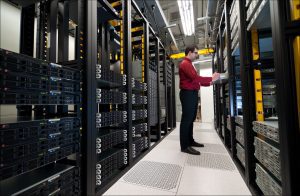The Internet of Things (IoT) was a big topic during 2015 and Gartner expects it to essentially spread its wings further in 2016. Gartner’s list of top strategic technology trends for 2016 includes a number of IoT spin-offs, all of which will create more data that will eventually wind up in a data center to be analyzed and stored.
Among the trends Gartner cites are the “device mesh,” which is “an expanding set of endpoints people use to access applications and information or interact with people, social communities, governments and businesses.” The device mesh includes IoT sensors but also wearable technology, consumer and home electronics and more.
All of these devices produce, use and transmit information, Gartner says, resulting in what it calls “Information of Everything.” It includes not just text, audio and video, but “sensory and contextual information,” Gartner says, along with advanced databases that “bring meaning to the often chaotic deluge of information.”
Then there’s the IoT Platforms, which Gartner says “constitutes the work IT does behind the scenes from an architectural and a technology standpoint to make the IoT a reality.”
While I suspect Gartner is a bit ahead of the technology curve as compared to the average enterprise, the point is that companies will have to deal with more and more data from all sorts of existing and emerging devices. Most of it will feed into those advanced databases that Gartner references, and most of those will run on high-powered computers in a data center. All of which means the demand for data center capacity will likely continue unabated.
To keep up, data center owners will want to build on the advancements we’ve seen in years past by focusing on the following three key areas.
1. Flexible, agile data centers – fast
Companies will need to be able to build new or expanded data centers quickly in order to keep up with business demand, while ensuring they are at once reliable and flexible. We’ve seen companies use prefabricated modular data center solutions to do just that in recent years and expect this trend to continue. Such modular systems shave months if not years off the time it takes to build a data center. The resulting data center is also more reliable because many components are assembled and tested in the factory, under highly controlled conditions – a far more reliable approach than assembling components in the field.
2. Fully optimized data centers
Handling all the data that IoT environments create – and other forms of Big Data – creates stress on data centers that can lead to higher energy use and increased costs. Following Data Center Lifecycle Services (DCLS) best practices can help companies anticipate needs and respond in an efficient manner. DCLS helps data center owners:
- Assess the current state of their environment
- Consider available options and plan improvements
- Design a new or expanded data center that meets their goals
- Manage the construction of the new or expanded data center
- Optimize the operation of the data center over time
DCLS helps companies better adapt to change without sacrificing efficiency and reliability, a capability that promises to be important in 2016.
3. Data Center Infrastructure Management
Another crucial element for ensuring data center reliability and efficiency is data center infrastructure management (DCIM) tools such as Schneider Electric’s StruxureWare for Data Centers. DCIM has been steadily gaining traction the last several years and I expect the trend to continue in 2016.
DCIM enables customers to collect critical intelligence about their IT facility, alerting them to where hot spots are, where there’s available storage or server capacity, when capacity has been reached and more. In short, DCIM gives managers a better understanding of their data center and helps lower their total cost of ownership (TCO) by improving energy efficiency, maximize maximizing resource utilization. Ultimately, DCIM enables IT groups to more effectively and efficiently support business operations.
With trends like IoT and Big Data continuing unabated, it seems there will be no let up in the demand for data center capacity and efficiency in 2016. As data centers become more and more critical learn more about how to ensure it remains up to the task for years to come by downloading the free Schneider Electric white paper no. 124, “Preventive Maintenance Strategy for Data Centers.”



